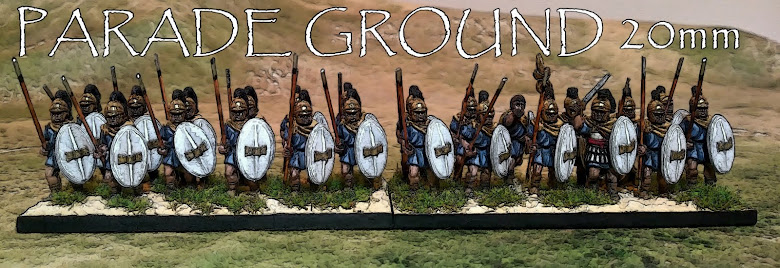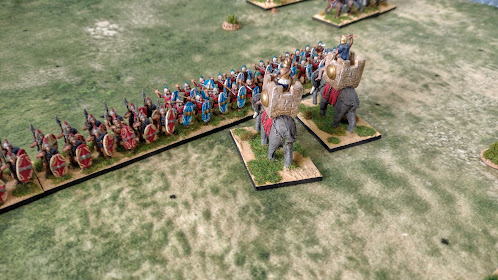In honour of
The Society of Ancients Battle Day 2024 I set up the battle of Ilipa using
Lost Battles by Philip Sabin, the successor rules to
Strategos II which is still offered on the society's store page. It's been a very long time since I was a member and hope to re-join one day in the not too distant future.
The scenario was set up as per the book, but when I set the battle away I realised I mixed up the Roman commanders so they swapped wings in comparison to the published scenario. I took a few photos of the Roman deployment with the back scene before swapping them for the Carthaginian pictures.
Ilipa pitches a Carthaginian army of roughly 70,000 infantry, 4000 cavalry and 32 elephants versus the Roman army of about 45,000 infantry and 3000 cavalry. A significant numerical advantage to the Punic army and Scipio took measures to equalise the fight. It involved Scipio deploying for battle day in day out, with his best Roman troops in the centre and his Iberian allies on the wings only to not commit to a fight that day. Hasdrubal mirrored the deployment, his best African troops in the centre and Iberians on the wings until one day they were roused earlier to form up for battle, so like every other day they deployed as before, but without being fed or watered.
However on that day Scipio was going to fight and his troops made sure they were prepared, furthermore Scipio's legions were opposing the Iberians on the wings and his allied Iberians were in the centre opposing Hasdrubal's African infantry. Now Scipio waited some time so that the Carthaginian infantry would feel the pang of hunger and being parched beyond human endurance. It was then when Scipio attacked.
With the Carthaginians on the back foot hoodwinked by Scipio deployment, he then further troubled Hasdrubal's army by flipping the turn order, this after deploying in a position to attack, allowed Scipio to launch the first strike. The Roman allied Caetratii struck the first blow against the Balearic slingers. On Silanus' wing the Romans caused a hit against the Elephants and Scipio's wing began to press the Carthaginian Scutarii. Both cavalry wings began to attack and the Roman allied Scutarii in the centre advanced to further pressurise the wrongfooted Punic army.
The Punic allied Iberian skirmishers are quickly brushed aside allowing Scipio's wing to rapidly apply pressure on the Punic right rear zone.
The isolated elephants brace the Roman assault taking a hit.
Despite this aggressive and vicious Roman advance, the Carthaginian army was not too battered. The Iberian cavalry unleashed a thunderous charge against the veteran Roman cavalry shattering the unit, a very early blow but it barely caused the Roman army to flinch.
The Iberian Cavalry swing around to threaten Scipio's wing
Fighting in the centre ensues, the Carthaginians hoping to break Rome's Spanish allies.
The Elephants, despite being spent, continue to cause concern to Silanus, while avoiding being shattered themselves.
The Iberians opposing Scipio, gave the legionaries much trouble, however become very fragile, but the Iberian cavalry operating behind the Legions becomes a distraction helping to prevent the Romans from inflicting that next hit, even with the personal leadership of Scipio.
The Punic Right Wing holds its own and inflicts hits on the Romans.
The Iberian Cavalry descend on the Romans inflicting a double hit on the spent Velites, they break but Scipio manages to rally the Legionaries taking the second hit.
The attack on the Elephants cause them to panic and inflict devastation on the Iberian Scutarii.
After inconclusive fighting the Roman cavalry inflict a double hit on the Numidians but owing to their nimbleness the light horsemen manage to avoid being shattered outright. This continued for a few more rounds before the Romans eventually prevailed and would go onto threaten the Punic left wing.
The Liby-Phonecian infantry in the centre pressed home their attacks, becoming spent themselves to inflict double hits. However because of fatigue this would make their future attacks more difficult.
Two units of Liby-Phonecian heavy infantry become shattered and the Punic light troops rout with them but the centre holds and continues to fight but owing to their fatigue struggle to land any hits.
The Iberians manage to inflict hits on the Legions across the field but Scipio keeps the line intact by rallying the troops and a morale boost by his mere presence.
The Punic centre collapses after two further shatters, Scipio figured them to be his biggest liability but they proved themselves resisting the Punic attacks, with help from the fatigue suffered by Hasdrubal's army. He tried to rally his troops but was himself struck down.
Silanus' wing was under some pressure from the relatively fresh Iberians, he did manage to prevent a unit from breaking by rallying them.
The tired Iberian cavalry struggle to hit home with their attacks.
The victorious Iberians begin to march around the Punic rear, if the Punic allied Iberians had been fresh they may have prevailed against Scipio's wing, Scipio feeling relieved that his underestimation of the Iberians didn't end in disaster. Despite rallying away hits previously eventually a unit of Roman veteran Legionaries were shattered. The Romans counter attacked and shattered a unit of Scutarii sending the remnants of the Punic force into flight.
The fighting became more desperate on the Roman right, a veteran legionary unit was shattered also on this wing however the Iberians were taking hits themselves and with the looming threat of Roman cavalry they routed when they realised that the Punic Right wing fled, leaving them the last remaining troops on the field, so took to flight leaving the Romans to finally expel Carthage from Hispania.
Victory points worked out from the book version:
Carthaginian losses: Shattered; AHI x 5, AEL x 1, ALC x 1, ALI x 1, Hasdrubal Killed.
Routed: ALI x 2, AHC x 1, AHI x 7.
127 VP for Rome
Roman losses: Shattered; VHC x 1, ALI x 1, VLE x 2.
Routed ALI x 1.
Spent; ALE x 2, VLE x 2, AHI x 4, ALI x 1.
71 VP for Carthaginians, a Major victory for Rome.
+46 VP for handicaps pushes it to a Narrow game victory for Rome.
As ever Lost Battles provided a tense and interesting solo re-fight. I didn't expect the Roman cavalry to be shattered so quickly, but Scipio's greatest asset was the fatigue suffered by Hasdrubal's troops. With spent heavy infantry needing to roll an 11 to cause a hit there were quite a few 10s which would have shattered lots of Scipio's units had they have been under normal circumstances. This affected the cavalry also that kept falling short of a hit and despite their initial breakthrough were unable to capitalise on it. There were some hits landed that would have caused shatters but Scipio rallied 2 units and Silanus rallied 1, however they couldn't rally them all, the Carthaginians managed to cause quite a bit of damage to the Romans and fought well. Overall the best fighters on the field were the Iberians on both sides, the Romans and African infantry attested to that, as well as the Roman cavalry.




















































